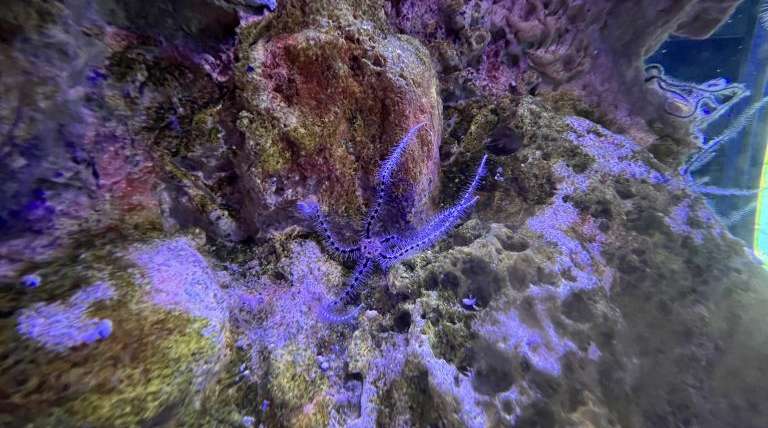Spongia cannabina (Lat. Axinella cannabina). It lives in caves and meadows of seagrass. It can grow up to 1 m. The sponge is upright, arboreal, with one shaft or with several branches. The surface is rough and animated by lobes and protrusions. The colour of the sponge is orange. It is prey to the species Phyllidia flava – sea slug. It is an…
Choose a language:
Small red scorpionfish (Lat. Scorpaena notata). It is a benthic species which may reach the 700 m of depth, even if, usually, it lives around the 200 m and it has been found at about 10 m. It leaves above rocky, sandy-muddy, sandy-gravel and bottom with meadows of Posidonia sp., mostly isolated. Grows till 22 cm, common 12 cm. Poison…
Common brittle star (Lat. Ophiotrix fragilis). It is most common on tide-swept rock and on coarse sediments, preferring hard substrates including sand and shingle. It is often found in empty shells or under stones, from the littoral zone down to 350 metres. Its disk may reach up to 2 cm in diameter. Five arms are long and spiny. The upper disk surface has…
The black scorpionfish (Lat. Scorpaena porcus). It is a venomous scorpionfish, common in marine subtropical waters. It is a benthic species and is usually found resting among seaweed and on rocks, and is usually solitary. It has a maximum length of about 37 cm (15 in) but a more normal adult length is around 15 cm (6 in). The colour of this fish is generally brownish and there is a…
Mediterranean red sea star (Lat. Echinaster sepositus). It is found at depths of 1 to 250 m (3–820 ft) in a wide range of habitats, including rocky, sandy and muddy bottoms, and sea grass meadows. It has five relatively slender arms around a small central disc. It usually has a diameter of up to 20 cm (8 in), but can exceptionally reach up to 30 cm (12 in). It…
The common lionfish (Lat. Pterois miles). It is a species of ray-finned fish native to the western Indo-Pacific region. The scientific name is from Greek pteron, meaning “wing”, and Latin miles, meaning “soldier”. It is usually found on the rocky bottom. It grows up to 35 cm (14 in) in length. The dorsal fin appears feathery and the pectoral fins are wing-like with separate broad, smooth…
Giant goby (Lat. Gobius cobitis). Coastal and benthic species, leaves above rocky and bottom with vegetation to depth of 10 m, common 2-5 m deep. Grows till 27 cm (0.4 kg). It is is greyish to olive brown with ‘pepper and salt’ markings. These are especially notable in smaller specimens. In the breeding season the male is darker than the…







